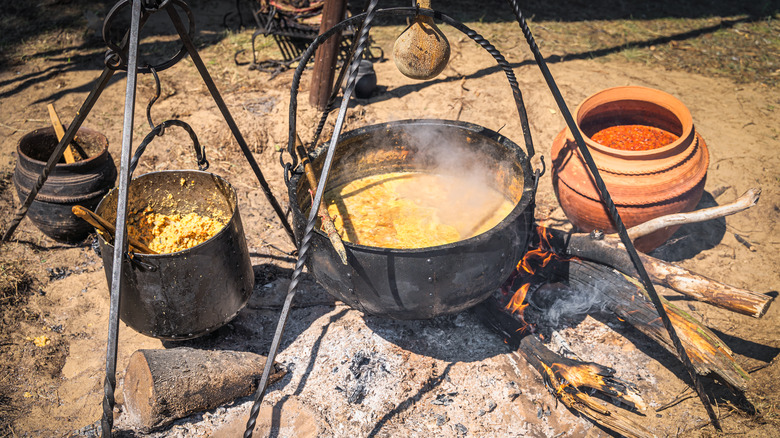The World's Oldest Bowl Of Soup Calls For An Ingredient You Won't Find In Any Kitchen
The history of unique soups has been funky from the start. We aren't talking about Anthony Bourdain's favorite traditional French fish head soup. We're going back to the beginning of humans making soup. The first bowl of soup known to man (or, at least, known to modern archaeologists) comes from one of the earliest civilizations in human history. An archaeological dig in modern-day Iraq uncovered evidence of soup made in 6000 B.C.E., and the main protein wasn't beef or chicken. It was hippopotamus.
The ancient Mesopotamians of the fertile crescent were chowing down on hippo meat, a meal that was surely hard-earned. Despite their jolly rotund figure and sedentary lifestyle, hippos are essentially giant, angry cows with lots of teeth. Adult hippos weigh 3,000 to 9,920 pounds and measure 10.8- to 16.5-feet long and roughly five feet tall, making hippos the third-largest land mammal walking the contemporary planet in 2024. Their canine teeth can grow to 20 inches long, and coupled with the animal's naturally aggressive disposition, turning a hippopotamus into soup was no small feat.
There aren't extensive records of the ancient Mesopotamian people eating hippos, but many lower-class Mesopotamians held the role of fisherman and sailors. Their protein diet consisted primarily of fresh-caught fish from rivers and man-made irrigation canals, and farmed livestock — mostly goats, pigs, sheep, geese, ducks, gazelle, and waterfowl. They also considered butter to be sacred.
Hippopotamus meat has a rich history of its own
So, what does hippo meat taste like? Hippos mostly eat grass (80 pounds of it) and scavenged fruit, but are also known to attack and eat zebras, wildebeests, and (yikes) cannibalize other hippos. Their meat is dark, like gamey beef with slight fishy brininess. To adequately tenderize, that ultra-lean meat must be slow-simmered, long-roasted, or stewed. Although, nowadays, eating hippo meat might be illegal in some regions depending on its fluctuating endangered species status.
At one time in not-far-off U.S. history, Congress considered introducing "hippopotamus steak" to the American dinner table. The country was locked in a meat shortage caused by the Beef Trust corporate meatpacking monopolies. To remedy the effects of the crisis, on March 24, 1910 then-senator Robert Broussard proposed the "American Hippo Bill" to the House Committee on Agriculture.
Broussard posited that hippos be shipped from Africa to Louisiana, where they could roam free-range and feed on the overpopulated water hyacinths, which had been overtaking Louisiana waterways and interrupting trade routes since the late 1800s. Plus, Broussard reasoned, the physically large animal would provide a lot of meat, and hippo farming presented enormous (pun intended) potential in America. The animal would thrive in the natural habitat of the swampy bayou, an area that could not be used to farm cattle. Congress ultimately ruled against the exotic proposal (obviously), but the roaring twenties might have looked a little more roaring in a safari way.

